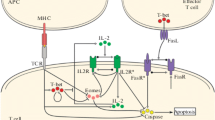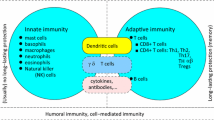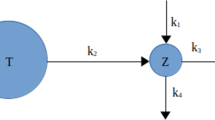Abstract
Cytokine storms are a potentially fatal exaggerated immune response consisting of an uncontrolled positive feedback loop between immune cells and cytokines. The dynamics of cytokines are highly complex and little is known about specific interactions. Researchers at the Ontario Veterinary College have encountered cytokine storms during virotherapy. Multiple mouse trials were conducted where a virus was injected into mice whose leukocytes lacked expression of the type I interferon receptor. In each case a rapid, fatal cytokine storm occurred. A nonlinear differential equation model of the recorded cytokine amounts was produced to obtain some information on their mutual interactions. Results provide insight into the complex mechanism that drives the storm and possible ways to prevent such immune responses.
You have full access to this open access chapter, Download conference paper PDF
Similar content being viewed by others
Keywords
- Time Series Data
- Severe Acute Respiratory Syndrome
- Toxic Shock Syndrome
- Severe Acute Respiratory Syndrome
- Oncolytic Virus
These keywords were added by machine and not by the authors. This process is experimental and the keywords may be updated as the learning algorithm improves.
1 Introduction
Overly robust cytokine responses are responsible for a broad array of very challenging and often fatal clinical conditions. These include infectious diseases such as influenza [16], severe acute respiratory syndrome (SARS) [11], bacteria-induced toxic shock syndrome [20] and sepsis [9], as well as multiple sclerosis [13], graft-versus-host disease [7] and sometime adverse effects of therapies [22]. Cytokines are released by cells to coordinate an immune response to help protect against foreign and/or dangerous matter. They are produced in response to infection and inflammation [5]. There are five major classifications of cytokines; interferons (IFN), interleukins (IL), chemokines, colony-stimulating factors (CSF), and tumour necrosis factors (TNF) [23]. Together they function in order to stimulate a response that will control cellular stress as well as minimize the amount of damage to a particular cell or group of cells [5].
Although the goal of each cytokine is to ultimately protect the host against dangerous insults, it is not uncommon for this process to become unbalanced. For reasons unknown, positive feedback loops can become up-regulated during an immune response involving complex interaction between cytokines and immune cells. The fine balance that is typical of healthy individuals is lost and gives rise to a cascade which is termed a cytokine storm. The dynamics of cytokines during normal immune responses and even more so during storms are highly complex and little is known about specific interactions [5, 27]. Cytokine storms not only have very negative effects on the immune response, they often have life threatening effects including a decrease in blood pressure, increase in heart rate and can often lead to death of the host [27].
As more biological data is collected, the immense complexities of the immune system is becoming increasingly apparent [26]. It is clear that mathematical modelling has become an essential tool to complement experimental techniques both in vitro and in vivo. Combining these approaches can result in major advancements in both the understanding of cancer and immune system dynamics including cytokine interactions, with the potential to identify strategies to control toxic cytokine storms [26].
Previous mathematical models include at most two cytokines and do not focus the research on the interactions and function of the cytokines. Typical cytokines included in models are IL-2, IL-10, IL-12 and TNF. Unfortunately, even the models that contain cytokines do not investigate the specific interactions that we are interested in. These models exclude many of the cytokines that are of greatest interest to us [6, 12, 15, 19].
Since our focus is to model only the dynamics of cytokines, we turn to ordinary differential equation (ODE) models to provide a good framework for exploring interactions between different cytokine populations. To keep the model relatively simple, we ignore the effects of effector cells (activated immune cells) due to the complexities it brings to the model. To date, the only model that is of a similar nature is produced by [27] called Dynamics of a Cytokine Storm. In this paper, the interactions of nine cytokines were modelled using data from a human clinical trial where six volunteers took part in a study that accidentally led them to undergo the effects of a cytokine storm [27]. This model was primarily constructed to look at the effects of the antibody responsible for the cytokine storm using a linear ODE model where parameter estimation determined coupling parameters between cytokines. The coupling parameters identified which cytokine was responsible for enhancing or inhibiting each other cytokine as well as self-regulation [27].
In this paper, we determine how cytokines interact with one another based on a set of time series data provided by Dr. Byram Bridle and his lab members Dr. Scott Walsh and Alexandra Rasiuk at the Ontario Veterinary College (OVC). Following administration of a highly attenuated virus to mice with leukocytes lacking the type I IFN receptor, a deadly cytokine storm developed leading to death in only 24 h. Down-regulation of anti-viral IFN signaling is a common mechanism used by viruses during infection, including those associated with cytokine storms (e.g. influenza virus [14], SARS-coronavirus [3] and Ebola virus [2]). Thus, a natural question arises: what are the specific dynamics of cytokines with respect to both initiating and exacerbating a cytokine storm when type I interferon signalling is impaired?
2 Mathematical Model
Most biological systems are innately non-linear and thus a non-linear ODE model is essential to obtain the proper dynamics [26]. The model we use is given by:
The first and most common assumption throughout the literature is that the concentration of a particular cytokine, x i , continues to decrease linearly when there is no outside stimulus [10, 17]. Since cytokines are secreted by other cells it makes sense that in the absence of these producers, the number of cytokines will rapidly decline at a rate μ i ( > 0) [10, 17, 25]. The second assumption is that the rate of production of cytokines is dependent on interactions with other cytokines and is sigmoidal in shape of the form
where M i ( > 0) is the maximum production rate. The interaction with other cytokines, y i , determines the slope of the function, and thus how much of a cytokine is produced, potentially offsetting some or all of the decay [10, 17, 25]. The interaction factor y i is given by
meaning that y i is composed of effects from the presence of other cytokines, α i, j ; effects from components for which there is no data, α 0, i ; and the stimulus, S i , by the virus. The stimulus is of the form
where there is an initial dose of the drug, b, which decays exponentially with characteristic time τ.
3 Data
Data was collected and provided by Dr. Byram Bridle, Dr. Scott Walsh and Alexandra Rasiuk who study the role of type I IFN signalling in the regulation of cytokine responses at the OVC. Chimeric mice were made by lethal irradiation of the bone marrow of C57BL/6 mice (Charles River Laboratories) followed by reconstitution with bone marrow from either wild-type or type I IFN receptor (IFNAR)-knockout donors (the latter provided by Laurel Lenz, University of Colorado School of Medicine). These mouse-based experiments were approved by the institutional Animal Care Committee and complied with the standard of the Canadian Council of Animal Care. These mice were infected intravenously with recombinant Vesicular Stomatitis Virus with a deletion of methionine at position 51 of the matrix protein (VSVΔm51) [21]. The matrix protein of VSV suppresses antiviral type I IFN responses. Therefore, this mutant virus renders the already attenuated laboratory strain of VSV even safer and it is being developed as an oncolytic virus for the treatment of cancers via intravenous infusion [24]. Surprisingly, mice lacking the IFNAR on their leukocytes experienced a profound cytokine storm, ultimately leading to death in only 24 h. The resulting time series data provided concentrations of 13 different cytokines in plasma, measured using a multiplex array (BioRad).
Concentrations of 13 cytokines were recorded at times 0, 2.5, 5, 10 and 24 h for both the wild-type mice and mice lacking the IFNAR on 20% of their leukocytes. Raw data was then normalized to account for the vast variability in the concentrations. This was done by dividing the concentration at each time point by the sum of the concentrations across all time points for a particular cytokine. In order to produce an accurate fit to the model it was essential to group cytokines to reduce the number of parameters. Grouping was based on the inflammatory classification of each cytokine as well as similarity of cytokine profile. The time at which the peak concentration occurred was recorded along with either the pro- or anti-inflammatory classification. Groupings can be seen in Table 1. Parameter estimation techniques, specifically fmincon in MATLAB, were used to fit the model to the data. The cost function is the typical least squares function with a normalization matrix to offset discrepancies between groups.
4 Results
Mathematical analysis is an important tool for biological predictions and for producing more questions and further areas of research both in biology and mathematics [1]. Model results from parameter optimization of IFNAR-knockout mice data are shown in Fig. 1. The model provides an accurate fit to the cytokine time series data for both IFNAR-knockout and wild-type mice (not shown). The model parameters that provide the most interesting information are the α i, j values, as they relate how each cytokine group interacts with each of the other groups. The sign and magnitude of these values indicate the type of effect a particular cytokine has; a negative parameter value indicates an inhibitory effect, a positive value an enhancing effect and the largest magnitude produces the most significant coupling. The three largest α i, j values for each group of the IFNAR-knockout mice are displayed in Fig. 2 where the lines indicate either enhancing (solid line with an arrowhead) or inhibiting (dotted line with a ‘T’) and the line thickness displays the magnitude (the thicker the line, the greater the magnitude).
Preliminary results from Fig. 2 show that Groups 2, 4, 5 and 6 are the most significant. Each of them have a large number of interactions, multiple two-way paths, exhibit definite enhancement or inhibition, and fit well with what is known biologically.
The most significant group, Group 2, consists of three pro-inflammatory cytokines: MIP-1β, TNF-α and IL-12. Of the three, TNF-α is assumed to be the dominating cytokine. TNF has been thoroughly studied and is one of the most well known cytokines as it plays an important role in the outcome of immune function [18, 23]. Model results for Group 2 show that it is an integral part of six significant interactions and has multiple two-way paths, one with Group 5 and another with Group 7. All three interactions that affect Group 2 are enhancing, indicating that as the storm progresses, the amount of cytokine will continue to rise. TNF-α, along with IL-1β (found in Group 3), are considered early-response cytokines, occurring soon after an immune response is triggered. It is known biologically that TNF-α promotes the generation of IL-1β [23]. Although the results are not shown for the wild-type case, the model results indicate that in fact Group 2 does enhance Group 3. In the case of IFNAR-knockout mice however, Group 2 inhibits Group 3 (the relatively small interaction is not shown in Fig. 2). This difference begins to shed light on why a storm occurred in mice lacking IFNAR on leukocytes.
Another central group is Group 4 which is made up of two anti-inflammatory cytokines, IL-4 and IL-10, with the latter being a very prominent inhibitor. IL-10 is often produced once a cytokine storm has begun in an attempt to return the balance that has been lost, termed immunoparalysis. Although overproduction can often allow the host to survive the cytokine storm longer, it is not likely it will survive long term [8, 18, 23]. Model results for Group 4 show that there are six interactions that are significant as well as two primarily enhancing two-way interactions with Groups 3 and 5. The three interactions that affect Group 4 are all enhancing, meaning that the amount of Group 4 will likely increase as the storm continues. Biologically it is known that IL-10 plays a role in the down regulation of both TNF-α (Group 2) and IL-1β (Group 3) [18]. Referring to Fig. 2, the model verifies that in fact Group 4 does inhibit Group 2, however Group 4 enhances Group 3. This could be due to the grouping of cytokines, since Group 2 contains MIP-1β and IL-12 as well. On the contrary, in the wild-type case, Group 4 inhibits Group 3 while it enhances Group 2.
A well-studied cytokine that is known to be a key component of a cytokine storm is IL-6, Group 5, which has both pro- and anti-inflammatory properties and is a central cytokine used to assess cytokine responses in the host [23]. Figure 2 displays the importance of this group with the eight interactions and two primarily enhancing two-way paths. It is known biologically that the production of IL-6 is stimulated by TNF-α and IL-1β [23]. Results from the model using wild-type data verify that indeed both Groups 2 and 3 enhance Group 5, however the interaction between Group 3 and 5 is relatively small. IFNAR-knockout results shown in Fig. 2 imply that Groups 2 and 3 inhibit Group 5 and that those interactions are significant. Again, this can provide some insight into how a storm was able to occur.
Group 6, MIP-1α, is required for a typical inflammatory response to viruses [4]. It is a pro-inflammatory chemokine that inhibits proliferation of hematopoietic stem cells in vitro and in vivo [4]. Model results for MIP-1α show that six interactions are significant as well as a two-way interaction with Group 3. The three interactions that affect MIP-1α are both inhibiting and enhancing whereas in the wild-type case the interactions are purely enhancing, causing an increase in the amount of MIP-1α as the storm continues.
It has been noted that the fine balance of pro- and anti-inflammatory mechanisms is critical in maintaining stability, and if these mechanisms become unbalanced, the outcome may contribute to a cytokine storm [23]. Groups 1 and 4 are anti-inflammatory cytokines, while the remainder act primarily as pro-inflammatory cytokines. For wild-type populations, of the three most significant groups (2, 4, and 6), the anti-inflammatory cytokines are being inhibited, while the pro-inflammatory cytokines are being enhanced. This balance in this system becomes lost in mice lacking the IFNAR on their leukocytes, as shown in Fig. 2. Instead of the anti-inflammatory cytokines (Group 4) being inhibited, they are instead enhanced. Immediately it becomes apparent that the fine balance that is typical of healthy individuals has become unstable.
Future work including sensitivity analysis of cytokine groupings could provide further information on the significance of the groupings and individual cytokines. In conclusion, cytokines belonging to Groups 2, 4, 5 and 6, particularly TNF-α, IL-10, IL-6 and MIP-1β, have the largest effects on the dynamics of this particular cytokine storm. Changes introduced into the system by knocking out IFNAR cause key interactions to swap from enhancing to inhibiting and vice versa. It is possible that reducing the alterations in the effects of Groups 2, 4, 5 and 6 could lead to the reduction in severity and possibly even the entire storm.
References
Bellomo, N., Li, N.K., Maini, P.K.: On the foundations of cancer modelling: selected topics, speculations, and perspectives. World Sci. 18 (4), 593–646 (2008)
Chang, T.-H., Kubota, T., Matsuoka, M., Jones, S., Bradfute, S.B., Bray, M., Ozato, K.: Ebola zaire virus blocks type i interferon production by exploiting the host sumo modification machinery. PLoS Pathog. 5 (6), e1000493 (2009)
Chen, X., Yang, X., Zheng, Y., Yang, Y., Xing, Y., Chen, Z.: Sars coronavirus papain-like protease inhibits the type i interferon signaling pathway through interaction with the sting-traf3-tbk1 complex. Protein Cell 5 (5), 369–381 (2014)
Cook, D.N.: The role of mip-1α in inflammation and hematopoiesis. J. Leucoc. Biol. 59 (1), 61–66 (1996)
Dranoff, G.: Cytokines in cancer pathogenesis and cancer therapy. Nature 4 (1), 11–22 (2004)
Eftimie, R., Bramson, J.L., Earn, D.J.D.: Interactions between the immune system and cancer: a brief review of non-spatial mathematical models. Bull. Math. Biol. 73 (1), 2–32 (2011)
Ferrara, J.L.: Cytokine dysregulation as a mechanism of graft versus host disease. Curr. Opin. Immunol. 5 (5), 794–799 (1993)
Frazier, W.J., Hall, M.W.: Immunoparalysis and adverse outcomes from critical illness. Pediatr. Clin. N. Am. 55 (3), 647–668 (2008)
Harrison, C.: Sepsis: calming the cytokine storm. Nat. Rev. Drug Discov. 9 (5), 360–361 (2005)
Hone, A., van den Berg, H.: Mathematical analysis of artificial immune system dynamics and performance. In: Flower, D., Timmis, J. (eds.) In Silico Immunology, pp. 351–374. Springer, New York (2007)
Huang, J., Wu, S., Barrera, J., Matthews, K., Pan, D.: The Hippo signaling pathway coordinately regulates cell proliferation and apoptosis by inactivating Yorkie, the drosophila homolog of YAP. Cell 122 (3), 421–434 (2005)
Kirschner, D., Panetta, J.C.: Modeling immunotherapy of the tumor-immune interaction. J. Math. Biol. 37, 235–252 (1998)
Link, H.: The cytokine storm in multiple sclerosis. Mult. Scler. 4 (1), 12–15 (1998)
Medina, R.A., Garcia-Sastre, A.: Influenza a virus: new research developments. Nat. Rev. Microbiol. 9, 590–603 (2011)
Müller, J., Tjardes, T.: Modeling the cytokine network in vitro and in vivo. J. Theor. Med. 5 (2), 93–110 (2003)
Pothlichet, J., Meunier, I., Davis, B.K., Ting, J.P.-Y., Skamene, E., von Messling, V., Vidal, S.M.: Type I IFN triggers RIG-I/TLR3/NLRP3-dependent inflammasome activation in influenza A virus infected cells. PLoS Pathog. 9 (4), e1003256 (2013)
Read, M., Timmis, J., Andrews, P.S.: Empirical investigation of an artificial cytokine network. In: Bentley, P.J., Lee, D., Jung, S. (eds.) Artifical Immune Systems, pp. 340–351. Springer, Berlin/Heidelberg (2008)
Reis, E.A.G., Hagan, J.E., Ribeiro, G.S., Teixeira-Carvalho, A., Martins-Filho, O.A., Montgomery, R.R., Shaw, A.C., Ko, A.I., Reis, M.G.: Cytokine response signatures in disease progression and development of severe clinical outcomes for leptospirosis. PLoS Negl. Trop. Dis. 7 (9), e2457 (2013)
Rodríguez-Pérez, D., Sotolongo-Grau, O., Riquelme, R.E., Sotolongo-Costa, O., Antonio Santos Miranda, J., Antoranz, J.C.: Assessment of cancer immunotherapy outcome in terms of the immune response time features. Math. Med. Biol. 25, 287–300 (2008)
Silversides, J.A., Lappin, E., Ferguson, A.J.: Staphylococcal toxic shock syndrome: mechanisms and management. Curr. Infect. Dis. Rep. 12 (5), 392–400 (2010)
Stojdl, D.F., Lichty, B.D., tenOever, B.R., Paterson, J.M., Power, A.T., Knowles, S., Marius, R., Reynard, J., Poliquin, L., Atkins, H., Brown, E.G., Durbin, R.K., Durbin, J.E., Hiscott, J., Bell, J.C.: Vsv strains with defects in their ability to shutdown innate immunity are potent systemic anti-cancer agents. Cancer Cell 4 (4), 263–275 (2003)
Suntharalingam, G., Perry, M.R., Ward, S., Brett, S.J., Castello-Cortes, A., Brunner, M.D., Panoskaltsis, N.: Cytokine storm in a phase 1 trial of the anti-cd28 monoclonal antibody tgn1412. N. Engl. J. Med. 355 (10), 1018–1028 (2006)
Tisoncik, J.R., Korth, M.J., Simmons, C.P., Farrar, J., Martin, T.R., Katze, M.G.: Into the eye of the cytokine storm. Microbiol. Mol. Biol. Rev. 76 (1), 16–32 (2012)
Wollmann, G., Rogulin, V., Simon, I., Rose, J.K., van den Pol, A.N.: Some attenuate variants of vesicular stomatitis virus show enhanced oncolytic activity against human glioblastoma cells relative to normal brain cells. J. Virol. 84 (3), 1563–1573 (2010)
Wu, J.T., Kirn, D.H., Wein, L.M.: Analysis of a three-way race between tumor growth, a replication-competent virus and an immune response. Bull. Math. Biol. 66, 605–625 (2004)
Yates, A., Chan, C.C.W., Callard, R.E., George, A.J.T., Stark, J.: An approach to modelling in immunology. Brief. Bioinform. 2 (3), 245–257 (2001)
Yiu, H.H., Graham, A.L., Stengel, R.F.: Dynamics of a cytokine storm. PLOS One 7 (10), e45027 (2012)
Acknowledgements
This research was supported in part by the Government of Ontario and the University of Guelph.
Author information
Authors and Affiliations
Corresponding author
Editor information
Editors and Affiliations
Rights and permissions
Copyright information
© 2016 Springer International Publishing Switzerland
About this paper
Cite this paper
Waito, M., Walsh, S.R., Rasiuk, A., Bridle, B.W., Willms, A.R. (2016). A Mathematical Model of Cytokine Dynamics During a Cytokine Storm. In: Bélair, J., Frigaard, I., Kunze, H., Makarov, R., Melnik, R., Spiteri, R. (eds) Mathematical and Computational Approaches in Advancing Modern Science and Engineering. Springer, Cham. https://doi.org/10.1007/978-3-319-30379-6_31
Download citation
DOI: https://doi.org/10.1007/978-3-319-30379-6_31
Published:
Publisher Name: Springer, Cham
Print ISBN: 978-3-319-30377-2
Online ISBN: 978-3-319-30379-6
eBook Packages: Mathematics and StatisticsMathematics and Statistics (R0)






